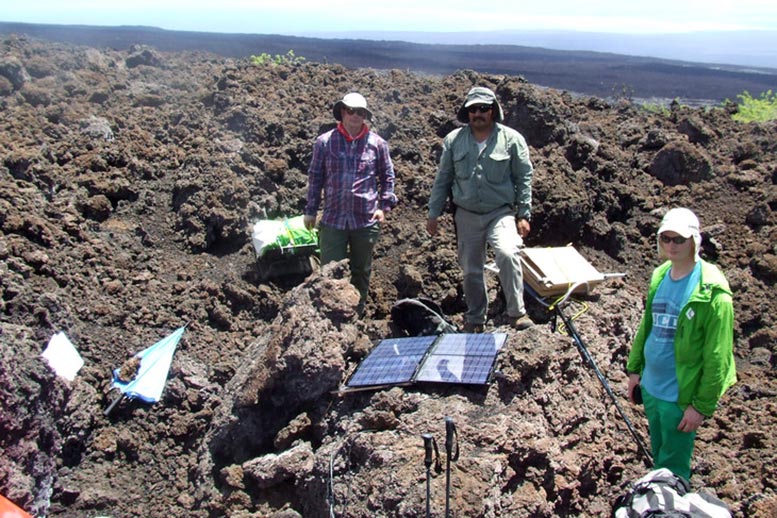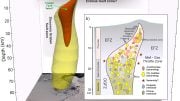
Field crew downloading data from a continuously operating Global Positioning station in the Sierra Negra caldera, Galapagos Islands, Ecuador. Credit: Keith Williams (UMAVCO, Inc)
Hours before the 2018 eruption of Sierra Negra, the Galápagos Islands’ largest volcano, an earthquake rumbled and raised the ground more than 6 feet in an instant. The event, which triggered the eruption, was captured in rare detail by an international team of scientists, who said it offers new insights into one of the world’s most active volcanoes.
“The power of this study is that it’s one of the first times we’ve been able to see a full eruptive cycle in this detail at almost any volcano,” said Peter La Femina, associate professor of geosciences at Penn State. “We’ve monitored Sierra Negra from when it last erupted in 2005 through the 2018 eruption and beyond, and we have this beautiful record that’s a rarity in itself.”
For nearly two months in 2018, lava erupted from the volcano, covering about 19 square miles of Isabela Island, the largest island in the Galápagos and home to about 2,000 people and endangered animal species like the Galápagos giant tortoise.
“The 2018 eruption of Sierra Negra was a really spectacular volcanic event, occurring in the ‘living laboratory’ of the Galápagos Islands,” said Andrew Bell, a volcanologist at the University of Edinburgh. “Great teamwork, and a bit of luck, allowed us to capture this unique dataset that provide us with important new understanding as to how these volcanoes behave, and how we might be able to better forecast future eruptions.”
While Sierra Negra is among the world’s most active volcanos, its remote location previously made monitoring difficult. Scientists now use networks of ground-based seismic and GPS monitoring stations and satellite observations to observe the volcano.
“Based on constant monitoring of activity of Galapagos volcanoes, we detected a dramatic increase of seismicity and a steady uplift of crater floor at Sierra Negra,” said Mario Ruiz, director of the Ecuador Geophysical Institute, the country’s national monitoring agency. “Soon we contacted colleagues from the United Kingdom, United States, and Ireland and proposed them to work together to investigate the mechanisms leading to an impending eruption of this volcano. This research is an example of international collaboration and partnership.”
The scientists captured data over 13 years as the volcano’s magma chamber gradually refilled following the 2005 eruption, stressing the surrounding crust and creating earthquakes. This continued until June 2018, when an earthquake occurred on the calderas fault system and triggered the subsequent eruption, the scientists said.
“We have this story of magma coming in and stressing the system to the point of failure and the whole system draining again through the eruption of lava flows,” La Femina said. “This is the first time anyone’s seen that in the Galápagos to this detail. This is the first time we’ve had the data to say, ‘Okay, this is what happened here.'”
Often during volcanic eruptions, as magma chambers empty the ground above them sinks and forms a bowl-like depression, or a caldera. But Sierra Negra experienced a caldera resurgence, leaving this area higher in elevation than it was before the eruption, the scientists said.
Inside the Sierra Negra caldera is a “trap-door fault,” which is hinged at one end while the other can be uplifted by rising magma. The scientists found the fault caused hills inside of the six-mile-wide caldera to lift vertically by more than 6 feet during the earthquake that triggered the eruption.
Caldera resurgence, important to better understanding eruptions, had not been previously observed in such detail, the scientists reported in the journal Nature Communications.
“Resurgence is typical of explosive calderas at volcanoes like Yellowstone, not the kind of shield volcanoes we see in the Galápagos or Hawaii,” La Femina said. “This gives us the ability to look at other volcanoes in the Galápagos and say, ‘Well that’s what could have happened to form that caldera or that resurgent ridge.'”
The scientists said the findings could help their counterparts in Ecuador better track unrest and warn of future eruptions.
“There are people who live on Isabella Island, so studying and understanding how these eruptions occur is important to manage the hazards and risks to local populations,” La Femina said.
Reference: “Caldera resurgence during the 2018 eruption of Sierra Negra volcano, Galápagos Islands” by Andrew F. Bell, Peter C. La Femina, Mario Ruiz, Falk Amelung, Marco Bagnardi, Christopher J. Bean, Benjamin Bernard, Cynthia Ebinger, Matthew Gleeson, James Grannell, Stephen Hernandez, Machel Higgins, Céline Liorzou, Paul Lundgren, Nathan J. Meier, Martin Möllhoff, Sarah-Jaye Oliva, Andres Gorki Ruiz and Michael J. Stock, 2 March 2021, Nature Communications.
DOI: 10.1038/s41467-021-21596-4
Other Penn State researchers on the project were Machel Higgins and Andres Gorki Ruiz, doctoral students, and Nathan Meier, a former undergraduate student.
Scientists from the Dublin Institute for Advanced Studies, Trinity College Dublin, the University of Cambridge, the University of Miami, Tulane University, NASA Goddard Space Flight Center and NASA Jet Propulsion Laboratory also contributed to the study.
The National Science Foundation, NASA and the Nature Environment Research Council funded this research.









When anyone speaks out online or by any other means and have not a solution or do not allow any solution to be said
YOU ARE PART OF THE PROBLEM
This is happening all too often with all these new online outlets !
Talks about a cool moment about a volcano on camera… doesnt show the video…. typical
With all the so called Science being spewed out lately with fake facts behind it, it does cause a great disservice to all scientists. Credibility is gone. People don’t believe anything anymore.
I am a gr’Gma, not a scientist.Comments mention deficiencies in this article, but I share the subject and ideas with my young ones. I tell them scientists do research and study things like this, but there is more study to be done, and sometimes new things are found out, new ideas thought. I love to see their excitement when I share, their wonderment and curiosity. Teach children to learn how to learn, and perhaps they will develop into problem servers, answer-seekers. critical thinkers. I appreciate these articles. Knowledge is a process. Thank you for all the articles.
Would have loved to have seen a video of it. Got click baited…
David Chura are you talking about yourself here? I don’t see a proposed solution to your problem.
Certainly would have been nice if there was a video to go along with the BS. Myself and others get really tired of hoping to see a video whenever we read and report such as this only to be strung along scrolling down and down and down and nothing. Makes scitechdaily look pretty stupid overall.
Never said video. Why is everyone expecting a video?
They captured a rare DATA SET showing, in detail, a large part of the island rose ~6′ rapidly.
I’d blame your own reading comprehension skills instead of claiming “click bait!”
It didn’t promise a video but it would’ve been great to include one.
The fact that the ground rose though, is exciting. These men & women are very brave to study volcanoes. I think it’s an important science, especially with so many volcanoes erupting this past week in the world.
Thank you for these informative articles!